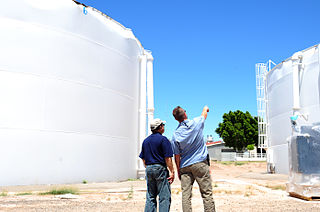The California Air Resources Board is an agency of the government of California that aims to reduce air pollution. Established in 1967 when then-governor Ronald Reagan signed the Mulford-Carrell Act, combining the Bureau of Air Sanitation and the Motor Vehicle Pollution Control Board, CARB is a department within the cabinet-level California Environmental Protection Agency.

The North Bay is a subregion of the San Francisco Bay Area, in California, United States. The largest city is Santa Rosa, which is the fifth-largest city in the Bay Area. It is the location of the Napa and Sonoma wine regions, and is the least populous and least urbanized part of the Bay Area. It consists of Marin, Napa, Solano and Sonoma counties.
The Metropolitan Transportation Commission (MTC) is the government agency responsible for regional transportation planning and financing in the San Francisco Bay Area. It was created in 1970 by the State of California, with support from the Bay Area Council, to coordinate transportation services in the Bay Area's nine counties: Alameda, Contra Costa, Marin, Napa, San Francisco, San Mateo, Santa Clara, Solano, and Sonoma. The MTC is fourth most populous metropolitan planning organization in the United States.

The Texas Commission on Environmental Quality (TCEQ) is the environmental agency for the state of Texas. The commission's headquarters are located at 12100 Park 35 Circle in Austin. The fourth-largest environmental agency in the United States, it employs about 2,780 employees, has 16 regional offices, and has a $420 million operating budget for the 2016 fiscal year.

Spare the Air is a program established by the Bay Area Air Quality Management District in 1991 to combat air pollution during the summer in the San Francisco Bay Area, the season when clear skies, hot temperatures, lighter winds, and a strong temperature inversion combine and trap air pollutants near the ground.

Ken Yeager is an American politician. He served on the Santa Clara County Board of Supervisors, representing District 4. First elected to the board in 2006, he represented the cities of Campbell and Santa Clara, as well as west San Jose and the Burbank and Cambrian neighborhoods. Previously, Yeager served on the San Jose City Council from 2000 to 2006. Before that, he served two terms on the San Jose/Evergreen Community College Board. He was a candidate for the 23rd district seat in the California State Assembly in 1996, coming in second.
The South Coast Air Quality Management District, also using the acronym South Coast (AQMD), formed in 1976, is the air pollution agency responsible for regulating stationary sources of air pollution in the South Coast Air Basin and the Coachella Valley portion of the Salton Sea Air Basin, in Southern California. The separate California Air Resources Board is responsible for regulating mobile sources (e.g. vehicles) in the air basin.

The United States produced 5.2 billion metric tons of carbon dioxide equivalent greenhouse gas (GHG) emissions in 2020, the second largest in the world after greenhouse gas emissions by China and among the countries with the highest greenhouse gas emissions per person. In 2019 China is estimated to have emitted 27% of world GHG, followed by the United States with 11%, then India with 6.6%. In total the United States has emitted a quarter of world GHG, more than any other country. Annual emissions are over 15 tons per person and, amongst the top eight emitters, is the highest country by greenhouse gas emissions per person.
United States vehicle emission standards are set through a combination of legislative mandates enacted by Congress through Clean Air Act (CAA) amendments from 1970 onwards, and executive regulations managed nationally by the Environmental Protection Agency (EPA), and more recently along with the National Highway Traffic Safety Administration (NHTSA). These standards cover tailpipe pollution, including carbon monoxide, nitrogen oxides, and particulate emissions, and newer versions have incorporated fuel economy standards. However they lag behind European emission standards, which limit air pollution from brakes and tires.

The Clean Air Act (CAA) is the United States' primary federal air quality law, intended to reduce and control air pollution nationwide. Initially enacted in 1963 and amended many times since, it is one of the United States' first and most influential modern environmental laws.

Pollution in California relates to the degree of pollution in the air, water, and land of the U.S. state of California. Pollution is defined as the addition of any substance or any form of energy to the environment at a faster rate than it can be dispersed, diluted, decomposed, recycled, or stored in some harmless form. The combination of three main factors is the cause of notable unhealthy levels of air pollution in California: the activities of over 39 million people, a mountainous terrain that traps pollution, and a warm climate that helps form ozone and other pollutants. Eight of the ten cities in the US with the highest year-round concentration of particulate matter between 2013 and 2015 were in California, and seven out of the ten cities in the US with the worst ozone pollution were also in California. Studies show that pollutants prevalent in California are linked to several health issues, including asthma, lung cancer, birth complications, and premature death. In 2016, Bakersfield, California recorded the highest level of airborne pollutants of any city in the United States.

The California State Water Resources Control Board (SWRCB) is one of six branches of the California Environmental Protection Agency.
The Carl Moyer Memorial Air Quality Standards Attainment Program is a State of California engine retrofit and replacement program implemented through the cooperative efforts of local air districts such as the Bay Area Air Quality Management District (BAAQMD) and the California Air Resources Board (ARB). The BAAQMD's Carl Moyer Program is managed by the Air District's Strategic Incentives Division (SID). The program provides grant funding to encourage the voluntary purchase of cleaner-than-required engines, equipment, and emission reduction technologies in an effort to rapidly reduce air pollution. While regulations continue to be the primary means to reduce air pollution emissions, the Carl Moyer Program plays a complementary role to California’s regulatory program by funding emission reductions that are surplus, that is, early and/or in excess of what is required by regulation.
The United States Environmental Protection Agency (EPA) began regulating greenhouse gases (GHGs) under the Clean Air Act from mobile and stationary sources of air pollution for the first time on January 2, 2011. Standards for mobile sources have been established pursuant to Section 202 of the CAA, and GHGs from stationary sources are currently controlled under the authority of Part C of Title I of the Act. The basis for regulations was upheld in the United States Court of Appeals for the District of Columbia in June 2012.
The California Statewide Truck and Bus Rule was initially adopted in December 2008 by the California Air Resources Board (CARB) and requires all heavy-duty diesel trucks and buses that operate in California to retrofit or replace engines in order to reduce diesel emissions. All privately and federally owned diesel-fueled trucks and buses, and privately and publicly owned school buses with a gross vehicle weight rating (GVWR) greater than 14,000 pounds, are covered by the regulation.
The Ventura County Air Pollution Control District (VCAPCD) protects public health and agriculture from the adverse effects of air pollution by identifying problems and developing a comprehensive program to achieve and maintain state and federal air quality standards. The Ventura County Board of Supervisors formed the district in response to the county's first air pollution study, which found the area had a severe air quality problem.
Commute.org is the transportation demand management (TDM) agency for San Mateo County, California, United States. Structured as a public joint powers agency, Commute.org is governed by a 19-member board made up of elected officials from 19 cities and towns as well as the County of San Mateo. In addition to the Board of Directors, there are also standing committees, Supervisory and Finance, which provide guidance and oversight to the agency.

The Porter-Cologne Water Quality Control Act is clean water act of California that expanded the enforcement authority of the State Water Resources Control Board and the 9 Regional Water Quality Control Boards. The act provided for the California Environmental Protection Agency to create the local boards and better protect water rights and water quality.
The San Joaquin Valley of California has seen environmental issues arise from agricultural production, industrial processing, and the region's use as a transportation corridor, experiencing some of the nation’s worst air quality, high rates of childhood asthma, and contaminated drinking water.









